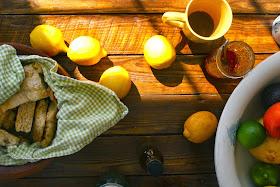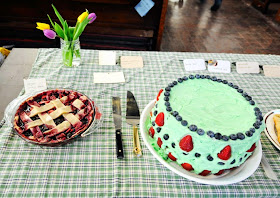I had already listened to the new Jake Xerxes Fussell album many times before the physical record arrived in the mail. I recognized a few of the songs as covers of traditional tunes, but I figured the rest were Fussell's own-- with their fresh melodies and original lyrics collaged with snippets of phrases from other old songs here and there.
When I finally inspected the back cover notes, I was surprised to find Fussell's attribution, "All songs are traditional;" the only personal credit taken for "performances & arrangements." He goes on to list extensive notes on the source recordings for each track, including musicians, locations, and dates, as well as other versions he draws from:
"Rabbit on a Log, Adapted from George Daniel, Boromville, AL | See: J.W. Warren's version recorded by George Mitchell, Ariton, AL, 1981: Jimmy Lee Harris's version recorded by George Mitchell, Phenix City, AL, 1981; Prairie Ramblers, "Gonna Have a Feast Here Tonight," 1933."
My surprise was not in how these old songs could sound so fresh, but because in my mind they are so fully adapted into something different and new, so infused with Fussell's artistry that he could easily have claimed them--
but didn't. There's certainly precedence in the folk music world for the types of authorial assertions he could have made--
Bob Dylan, Gillian Welch, and countless others are notorious for essentially ripping the melody from a trad tune, changing the words (sometimes not much) and calling it their own with no allusion to the influence. Even in the non-commercial folk music world, old-time fiddlers often claimed suspect ownership over melodies that so clearly did not originate with them (access to recordings now make this even more evident). On Fussell's self-titled album, it is the pointed and rather humble decision to credit all of his sources and influences that is especially salient.

Folk songs and traditional recipes are clear analogues and both represent major veins in my life-- I think often about their similarities. Recently, this connection was brought to mind again, via my friend
Lora, in Lesley Chesterman's article in the
Montreal Gazette,
"Plagiarism a Common Ingredient in the Wide World of Recipes." You should read it for yourself, but in short, Chesterman explores the frequent lack of accreditation (and sometimes pure lifting)-- from authors, cultures, and history alike-- in the food world.
In the article,
Naomi Duguid makes the direct connection between traditional music and recipes, "A recipe is like a folk song. There are always fresh interpretations, but everything comes from somewhere." This, for one, is why I don't really believe in "secret recipes"-- recipes weren't invented out of thin air-- they are all adaptations and evolutions from generations of creativity and experimentation and work. Why should one person reign over what was really not theirs to begin with? However, this doesn't mean recipes or songs need not be attributed. In fact, it suggests the opposite. My disdain for the notion of secret recipes does not mean that I think everything is public domain, but rather says that we should give credit where credit is due, acknowledge those cultures and communities and individual brains that recipes emerge from, rather than portray that process and resulting work removed from its context, its humanity. As Duguid says, "Always ask where a recipe's from and be aware that you are standing on people's shoulders."
I realize I'm merely touching on what is a huge and complicated issue in the world of folklore, intangible cultural heritage, and intellectual property (and I'm saying nothing about the financial economics of this) but for now, I'll say what I know is rather idealistic-- credit your sources, do your research, and expect others to do the same. Know and be assured in the knowledge that what is always uniquely yours are the "performances & arrangements." I'm sure I'll be circling back to these ideas and I'd love to hear your thoughts below, on this, or just some fine citrus preserves.
This recipe for Grapefruit & Temple Orange Jam-- essentially a rind-less marmalade, comes from Marisa of
Food in Jars' Grapefruit Jam, by way of Yossy of
Apt. 2B Baking's Grapefruit Bergamot Jam. I had a surplus of both oranges and grapefruit, so decided to bring them together here. The recipe could really work with any variation of citrus-- grapefruit, orange, tangerine, even Meyer Lemon. The result is a not-too-sweet jam, with a slight marmalade bitterness-- really an ideal combination.
Grapefruit & Temple Orange Jam
Adapted from Food In Jars via Apt. 2B Baking
Yields 2 pints
Ingredients
4 lbs. grapefruit & Temple oranges (about 6 grapefruit & 4 oranges, depending on size)
2 1/2 cup granulated white sugar
Directions
1. Supreme the citrus by cutting the top and bottom of the rind with a sharp knife, then cut off the rest of the rind and pith and discard. Once the rind is removed, cut the fruit sections away from the membrane, saving the membrane and seeds. Though labor intensive, this will make your jam much less bitter.
2. Put the naked fruit sections into a large pot and stir in the sugar until it begins to dissolve. Tie the membranes and seeds in a cheesecloth and toss into the pot-- these will add natural pectin while you cook the jam.
3. Place pot over high heat and bring fruit mixture to a boil. Cook at a simmer, stirring regularly, until jam reaches 220 degrees F or passes the "wrinkle test" i.e. its set point. Once your jam is ready, remove the cheesecloth bundle and ladle it into sterilized and prepared jars, leaving 1 cm, of head space.
4. Place lids on top and screw bands "fingertip tight". Process jars in water bath canner (or follow instructions for whatever canning method you are using). Remove and let cool completely until jar tops pop. Jam keeps at room temperature for up to one year. Refrigerate after opening.
Related recipes:
Grapefruit-Ginger Marmalade
Meyer Lemon-Honey Marmalade Linzer Torte
Satsuma Orange Galette with a Cream Cheese Crust
Shaker Orange Tarts




















